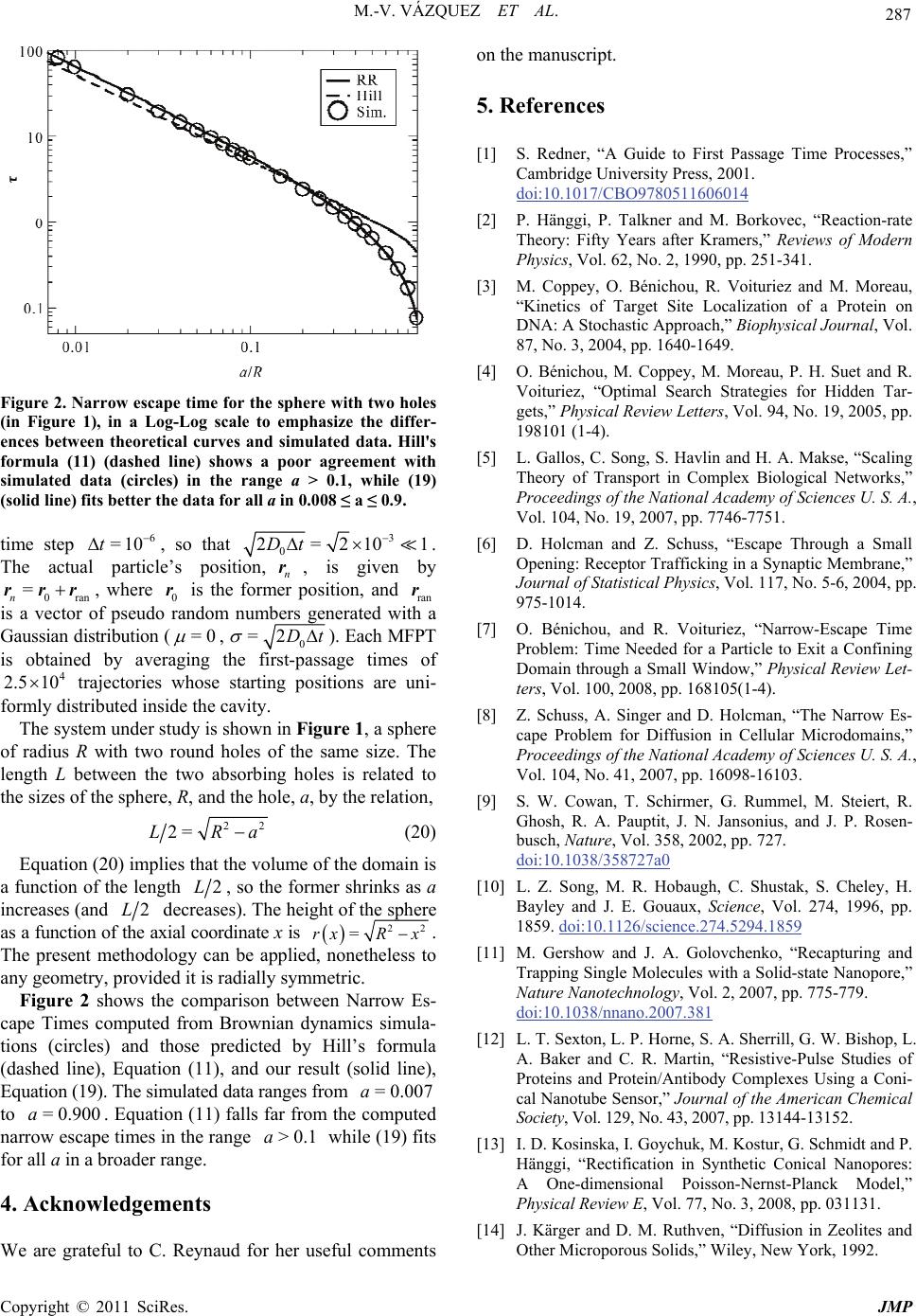
M.-V. VÁZQUEZ ET AL.
287
Figure 2. Narrow escape time for the sphere with two holes
(in Figure 1), in a Log-Log scale to emphasize the differ-
ences between theoretical curves and simulated data. Hill's
formula (11) (dashed line) shows a poor agreement with
simulated data (circles) in the range a > 0.1, while (19)
(solid line) fits better the data for all a in 0.008 ≤ a ≤ 0.9.
time step , so that
6
=10t
3
0
2=210Dt
1.
The actual particle’s position, n, is given by
0ran
, where 0 is the former position, and ran
is a vector of pseudo random numbers generated with a
Gaussian distribution (
r
=
nrrr r r
=0
,0
=2Dt
). Each MFPT
is obtained by averaging the first-passage times of
trajectories whose starting positions are uni-
formly distributed inside the cavity.
4
2.5 10
The system under study is shown in Figure 1, a sphere
of radius R with two round holes of the same size. The
length L between the two absorbing holes is related to
the sizes of the sphere, R, and the hole, a, by the relation,
22
2=LRa
(20)
Equation (20) implies that the volume of the domain is
a function of the length 2L, so the former shrinks as a
increases (and 2L decreases). The height of the sphere
as a function of the axial coordinate x is
22
=rxR x
.
The present methodology can be applied, nonetheless to
any geometry, provided it is radially symmetric.
Figure 2 shows the comparison between Narrow Es-
cape Times computed from Brownian dynamics simula-
tions (circles) and those predicted by Hill’s formula
(dashed line), Equation (11), and our result (solid line),
Equation (19). The simulated data ranges from
to . Equation (11) falls far from the computed
narrow escape times in the range while (19) fits
for all a in a broader range.
=0.007a
=0.900a
>0.1a
4. Acknowledgements
We are grateful to C. Reynaud for her useful comments
on the manuscript.
5. References
[1] S. Redner, “A Guide to First Passage Time Processes,”
Cambridge University Press, 2001.
doi:10.1017/CBO9780511606014
[2] P. Hänggi, P. Talkner and M. Borkovec, “Reaction-rate
Theory: Fifty Years after Kramers,” Reviews of Modern
Physics, Vol. 62, No. 2, 1990, pp. 251-341.
[3] M. Coppey, O. Bénichou, R. Voituriez and M. Moreau,
“Kinetics of Target Site Localization of a Protein on
DNA: A Stochastic Approach,” Biophysical Journal, Vol.
87, No. 3, 2004, pp. 1640-1649.
[4] O. Bénichou, M. Coppey, M. Moreau, P. H. Suet and R.
Voituriez, “Optimal Search Strategies for Hidden Tar-
gets,” Physical Review Letters, Vol. 94, No. 19, 2005, pp.
198101 (1-4).
[5] L. Gallos, C. Song, S. Havlin and H. A. Makse, “Scaling
Theory of Transport in Complex Biological Networks,”
Proceedings of the National Academy of Sciences U. S. A.,
Vol. 104, No. 19, 2007, pp. 7746-7751.
[6] D. Holcman and Z. Schuss, “Escape Through a Small
Opening: Receptor Trafficking in a Synaptic Membrane,”
Journal of Statistical Physics, Vol. 117, No. 5-6, 2004, pp.
975-1014.
[7] O. Bénichou, and R. Voituriez, “Narrow-Escape Time
Problem: Time Needed for a Particle to Exit a Confining
Domain through a Small Window,” Physical Review Let-
ters, Vol. 100, 2008, pp. 168105(1-4).
[8] Z. Schuss, A. Singer and D. Holcman, “The Narrow Es-
cape Problem for Diffusion in Cellular Microdomains,”
Proceedings of the National Academy of Sciences U. S. A.,
Vol. 104, No. 41, 2007, pp. 16098-16103.
[9] S. W. Cowan, T. Schirmer, G. Rummel, M. Steiert, R.
Ghosh, R. A. Pauptit, J. N. Jansonius, and J. P. Rosen-
busch, Nature, Vol. 358, 2002, pp. 727.
doi:10.1038/358727a0
[10] L. Z. Song, M. R. Hobaugh, C. Shustak, S. Cheley, H.
Bayley and J. E. Gouaux, Science, Vol. 274, 1996, pp.
1859. doi:10.1126/science.274.5294.1859
[11] M. Gershow and J. A. Golovchenko, “Recapturing and
Trapping Single Molecules with a Solid-state Nanopore,”
Nature Nanotechnology, Vol. 2, 2007, pp. 775-779.
doi:10.1038/nnano.2007.381
[12] L. T. Sexton, L. P. Horne, S. A. Sherrill, G. W. Bishop, L.
A. Baker and C. R. Martin, “Resistive-Pulse Studies of
Proteins and Protein/Antibody Complexes Using a Coni-
cal Nanotube Sensor,” Journal of the American Chemical
Society, Vol. 129, No. 43, 2007, pp. 13144-13152.
[13] I. D. Kosinska, I. Goychuk, M. Kostur, G. Schmidt and P.
Hänggi, “Rectification in Synthetic Conical Nanopores:
A One-dimensional Poisson-Nernst-Planck Model,”
Physical Review E, Vol. 77, No. 3, 2008, pp. 031131.
[14] J. Kärger and D. M. Ruthven, “Diffusion in Zeolites and
Other Microporous Solids,” Wiley, New York, 1992.
Copyright © 2011 SciRes. JMP